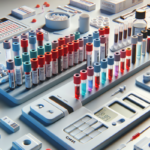Enhancing Patient Safety Through a Detailed Analysis of Blood Test Lab Risks
Blood tests are vital diagnostic tools used for identifying and monitoring various health issues, yet they come with inherent risks that can profoundly affect patient results and treatment outcomes. It is essential for patients and healthcare professionals alike to develop a comprehensive understanding of the diverse and complex nature of blood test lab risks. By highlighting these often-neglected threats, we can navigate the intricacies of laboratory testing more effectively, ensuring that patient safety remains at the forefront of healthcare practices.
Identifying Common Laboratory Errors and Their Impact on Patient Care

The realm of laboratory testing is exceptionally intricate, and even the slightest error can lead to serious consequences for patients. Laboratory errors can arise at multiple stages, including pre-analytical errors during sample collection and handling, as well as analytical errors that occur during the testing phase itself. For instance, incorrect diagnoses can stem from improperly labelled samples, contamination, or the selection of inappropriate tests, ultimately leading to severe repercussions for patient care and treatment outcomes.
In instances where a blood sample is not processed within the specified timeframe, the accuracy and reliability of the results may be compromised, potentially resulting in false positives or negatives that can dramatically alter treatment pathways. Moreover, misinterpretations of test results can occur if laboratories fail to follow established protocols, highlighting the critical importance of maintaining rigorous standards in <a href=”https://bloodtest.co.uk/private-blood-testing-in-clerkenwell-a-refreshing-take/”>blood testing</a> to protect patients from adverse outcomes.
Assessing the Role of Human Error in Laboratory Testing Mistakes
Human error is an unavoidable factor in all professional settings, and laboratories are no exception. The risks associated with blood tests and errors committed by laboratory technicians can lead to severe negative consequences for patients. These errors can stem from a variety of causes, including technician fatigue, inadequate training, or simple oversight. For example, a technician might mistakenly label a blood sample or fail to adhere to established standard operating procedures, leading to incorrect test results that could jeopardize patient health and wellbeing.
Additionally, communication breakdowns among laboratory personnel can exacerbate these issues. If critical details about a patient's medical history are not effectively shared, it may negatively impact how lab results are interpreted. To minimize these risks, it is crucial for laboratories to foster a culture centered on safety, encouraging team members to double-check their work and maintain open communication regarding any potential concerns that may arise during the testing process.
Examining the Consequences of Technological Failures on Test Results
While technological advancements have revolutionized laboratory practices, they are not without their own set of risks that can threaten test accuracy. Equipment failures can severely compromise the results of blood tests, leading to misdiagnoses and inappropriate treatment options. For instance, a malfunctioning analyser may produce inconsistent or incorrect results, necessitating additional tests or unnecessary interventions that could complicate patient care and outcomes.
Moreover, an overreliance on technology can create a false sense of security within laboratories. To maintain optimal performance, it is essential for laboratories to conduct regular maintenance and calibration of their equipment. Additionally, establishing robust backup systems can help identify errors before they negatively impact patient care. By acknowledging the potential for technological failures, laboratories can proactively implement safeguards that protect their processes and ultimately enhance patient safety.
Exploring the Legal and Ethical Considerations of Blood Test Lab Risks

As we delve deeper into the complexities surrounding blood test lab risks, the importance of understanding the legal and ethical frameworks that govern these issues becomes increasingly clear. Patients have the inherent right to be informed about their rights and the recourse options available to them should they become victims of laboratory errors or mistakes.
Empowering Patients with Knowledge of Their Rights in Medical Testing
Patients are entitled to a defined standard of care regarding medical testing. This includes the right to receive accurate test results and clear communication about any potential risks involved. Patients should be well-versed in their rights to seek clarification and hold laboratories accountable when faced with testing errors, ensuring they are not left vulnerable to the consequences of negligence.
Furthermore, patients have a responsibility to provide accurate and comprehensive information concerning their medical history and any medications they are currently taking. This information can significantly influence test results and help minimize the risks associated with blood testing. By fostering a collaborative relationship with healthcare providers, patients can actively contribute to their safety and overall care, enhancing their involvement in the healthcare process.
Exploring Legal Options Following Misdiagnosis Due to Lab Errors
When blood test lab risks lead to misdiagnosis, patients may have legal avenues available to them. It is essential for affected individuals to understand the steps they should take in such situations. Patients should meticulously document all communications with healthcare providers and gather pertinent evidence relating to the misdiagnosis, including medical records and test results that support their claims.
Consulting with a legal professional specializing in medical malpractice can provide critical guidance on pursuing a claim. It is vital to demonstrate that the laboratory or healthcare provider failed to meet the accepted standard of care, which subsequently resulted in harm. Although navigating this intricate legal process may seem daunting, it is crucial for patients to hold those responsible for lab errors accountable for their actions.
Ethical Considerations in Reporting Laboratory Errors

Ethics plays a pivotal role in promoting accountability and transparency within laboratory operations. Healthcare providers and laboratories carry a moral obligation to inform patients about errors, ensuring they are aware of the potential health impacts and treatment implications. This transparency not only builds trust between patients and providers but also fosters a culture of accountability within the laboratory setting.
While reporting lab errors may be uncomfortable for staff, it is essential for improving laboratory practices and preventing future mistakes. Laboratories should establish clear protocols for error reporting and cultivate an environment where employees feel empowered to raise concerns about issues without fear of retaliation. By prioritizing ethical considerations, laboratories can greatly enhance patient safety and contribute to a more resilient healthcare system.
Developing Effective Strategies to Minimize Blood Test Lab Risks
Addressing the complex nature of blood test lab risks requires a comprehensive approach. By implementing effective strategies, laboratories can significantly reduce the likelihood of errors and enhance the accuracy of test results.
Implementing Robust Quality Control Measures in Laboratories
Quality control serves as the bedrock of any reputable laboratory. By instituting stringent quality control protocols, laboratories can minimize errors at every stage of the testing process. This includes regular equipment calibration, proficiency testing, and strict adherence to established standard operating procedures, all of which are vital components of a comprehensive quality control strategy.
Moreover, laboratories should establish a continuous monitoring system to detect trends and potential issues early on. By analyzing data on error rates and taking timely corrective actions, labs can foster a culture of continuous improvement that prioritizes patient safety and satisfaction. This proactive approach not only enhances the quality of care provided but also builds trust with patients.
The Crucial Importance of Ongoing Staff Training and Certification
A well-trained workforce is essential for minimizing blood test lab risks. Ensuring that laboratory personnel receive adequate training and certification can significantly improve the accuracy and dependability of test results. Regular training sessions and workshops are critical for keeping staff updated on the latest protocols and technologies within the field.
Encouraging a culture of continuous learning and development also fosters a sense of ownership among staff regarding their roles and responsibilities. When laboratory personnel feel confident in their skills and knowledge, they are more likely to adhere to best practices, ultimately reducing the occurrence of errors and enhancing overall patient care.
Leveraging Advanced Technology to Enhance Blood Testing Accuracy
Embracing state-of-the-art technological advancements can greatly improve the precision of blood tests. Automated systems, for example, can markedly reduce human error by streamlining procedures and minimizing the need for manual input during the testing process. By integrating technology into laboratory workflows, labs can achieve a superior level of accuracy in their testing protocols.
Additionally, utilizing data analytics within laboratory operations enables more informed decision-making. By examining trends and patterns in test results, laboratories can identify areas for improvement and implement targeted strategies to effectively mitigate risks. The future of laboratory testing hinges on successfully merging human expertise with innovative technological solutions, ultimately enhancing patient safety and care.
Exploring the Financial Implications of Blood Test Lab Risks
The repercussions of blood test lab risks extend beyond patient health, imposing significant financial burdens on healthcare providers, patients, and the healthcare system as a whole. Understanding these costs is crucial for all stakeholders involved in the healthcare process.
The Financial Impact of Lab Errors on Healthcare Providers
Healthcare facilities, including laboratories and hospitals, can face substantial economic repercussions as a result of lab errors. Misdiagnoses often lead to unnecessary treatments, extended hospital stays, and additional testing, all of which contribute to escalating healthcare costs. Furthermore, the reputational damage associated with a pattern of errors may deter patients from seeking care at specific institutions, compounding the financial strain on these facilities.
To alleviate these costs, healthcare providers should prioritize investments in quality assurance programs and comprehensive staff training initiatives. By focusing on patient safety and reducing error rates, laboratories can enhance their financial sustainability while simultaneously improving patient outcomes and fostering trust in their services.
Navigating Insurance and Liability Issues Related to Lab Errors
Insurance coverage plays a crucial role in managing blood test lab risks. Laboratories must navigate the complexities of liability insurance, which can become contentious in cases involving misdiagnosis or lab errors. Understanding the intricacies of insurance coverage can better equip laboratories to prepare for potential legal challenges and claims.
In situations where lab errors result in patient harm, individuals may seek compensation through their insurance or pursue legal action against the responsible parties. Laboratory management must ensure they maintain adequate insurance coverage to protect against these risks and effectively address any claims that may arise, thereby safeguarding their operations and reputation.
Assessing the Financial Impact on Patients Due to Lab Errors
Patients can encounter significant financial challenges as a result of blood test lab risks. Misdiagnoses may lead to unnecessary treatments and follow-up tests, which can substantially increase out-of-pocket expenses. Additionally, patients may face higher premiums or deductibles if their insurance rates rise due to lab errors affecting their healthcare journey.
To mitigate these financial burdens, patients should actively seek to understand their insurance coverage and advocate for transparent communication with their healthcare providers. By doing so, they can make informed choices that ultimately protect their financial wellbeing and ensure they receive the necessary care without undue stress.
Gaining Insight Through Case Studies on Blood Test Lab Risks
Investigating real-world case studies involving blood test lab risks offers valuable insights into the potential ramifications of lab errors and emphasizes the importance of effective mitigation strategies.
Analyzing High-Profile Case Studies and Their Outcomes
High-profile instances of lab errors have garnered public attention, highlighting the serious consequences that can stem from blood test lab risks. For example, one widely publicized case involved a laboratory that reported inaccurate cancer marker results, leading to incorrect diagnoses and unnecessary treatments for many patients. The fallout from such incidents often includes not only a loss of patient trust but also significant legal repercussions for the laboratory involved.
These cases serve as stark reminders of the necessity for maintaining rigorous standards and transparency in laboratory operations. They prompt a reevaluation of protocols and encourage laboratories to adopt more stringent quality control measures to prevent similar occurrences, ultimately enhancing patient safety.
Learning from Successful Error Reduction Strategies
Conversely, there are also success stories from laboratories that have effectively reduced their error rates through targeted initiatives. By investing in staff training, implementing quality control measures, and utilizing innovative technology, these laboratories have significantly improved their accuracy and reliability.
For instance, one laboratory that implemented an automated sample tracking system saw a remarkable decrease in mislabeled specimens and other pre-analytical errors. Such success stories illustrate the potential for advancement within the laboratory industry and motivate others to enhance their practices for the benefit of patient care and safety.
The Importance of Public Reporting and Transparency in Laboratory Performance
Publicly reporting lab error rates can significantly enhance laboratory practices. By making this information available, laboratories are held accountable for their performance, fostering a culture of transparency and continuous improvement.
Patients stand to gain immensely from this transparency, empowering them to make informed decisions about their care. When patients are aware of a laboratory's performance history, they can advocate for their safety and demand higher standards of care in their healthcare experiences, ultimately improving overall patient satisfaction.
The Transformative Impact of Technology on Blood Test Lab Risks
As technology continues to progress, the potential for reducing blood test lab risks grows exponentially. Embracing these innovations can lead to more accurate and reliable testing outcomes for patients.
The Automation Revolution in Blood Testing Procedures
Automation has significantly reshaped the landscape of laboratory testing by greatly mitigating the risk of human error. Automated systems streamline every step of the process, from sample collection to analysis, thereby reducing the likelihood of mistakes that can occur during manual handling.
For example, automated pipetting systems deliver precise measurements, while robotic systems can efficiently process samples, alleviating the burden on laboratory staff. By integrating automation into testing workflows, laboratories can enhance both accuracy and efficiency, ultimately benefiting patient safety and care.
Utilizing AI and Machine Learning for Superior Lab Diagnostics
The integration of artificial intelligence (AI) and machine learning into laboratory diagnostics presents tremendous potential. These technologies can analyze extensive datasets to uncover patterns and anomalies that may evade human technicians.
AI-driven algorithms can assist in interpreting complex test results, leading to more accurate diagnoses and a reduction in errors. As these technologies advance, they are anticipated to play an increasingly significant role in enhancing the reliability of blood tests and overall laboratory practices, paving the way for improved patient outcomes.
Emerging Trends Shaping the Future of Laboratory Technology
Several emerging technologies show promise in further minimizing blood test lab risks. Innovations such as point-of-care testing, which allows for immediate results at the care site, are gaining traction and acceptance. This approach not only enhances patient convenience but also mitigates risks associated with sample transport and processing, making testing more efficient.
Additionally, advancements in biosensors and molecular diagnostics possess the potential to revolutionize the accuracy of blood testing methodologies. By staying informed about these developments, laboratories can position themselves at the cutting edge of innovation and significantly improve patient safety and quality of care.
Addressing Patient Concerns Regarding Blood Test Lab Risks
Patients frequently harbor concerns about the safety and accuracy of blood testing. Effectively addressing these apprehensions is crucial for building trust and promoting a collaborative healthcare experience.
Identifying and Addressing Common Fears and Misconceptions
Many patients voice concerns about the accuracy of blood tests, fearing that errors may lead to misdiagnoses or inappropriate treatments. Additionally, worries about the potential risks associated with blood draws, such as infection or excessive bruising, can heighten anxiety surrounding the testing process.
By educating patients about the stringent protocols and safeguards employed by laboratories, healthcare providers can help alleviate these fears. Providing clear information about the testing process and the measures in place to ensure accuracy and safety can instill confidence in patients, empowering them to engage actively in their healthcare journey.
Effective Communication Strategies to Build Trust with Patients
Clear and open communication is essential for addressing patient concerns regarding blood test lab risks. Laboratories should prioritize transparency, ensuring that patients receive timely updates about their test results and any potential issues that may arise during the testing process.
Furthermore, training staff in effective communication skills can significantly enhance the patient experience. By fostering a culture of empathy and understanding, laboratories can cultivate stronger relationships with patients, ultimately improving trust and satisfaction within the healthcare environment.
Empowering Patients Through Education on Lab Risks
Equipping patients with knowledge about blood test lab risks is vital for fostering safety and effective care. Informed patients are more likely to advocate for themselves and ask pertinent questions regarding their health and treatment plans.
Laboratories can implement educational initiatives designed to inform patients about the testing process, potential risks, and their rights. By equipping patients with necessary information, labs can create a healthcare environment that emphasizes safety, collaboration, and informed decision-making.
Understanding the Regulatory Frameworks Governing Blood Test Lab Risks
The regulatory frameworks that govern laboratory practices play a crucial role in defining the landscape of blood test lab risks. Familiarity with these regulations is essential for ensuring compliance and enhancing patient safety across healthcare settings.
Compliance with National and International Safety Standards
Laboratories are required to adhere to a range of national and international standards designed to ensure safety and quality in testing procedures. Regulations established by organizations such as the Clinical Laboratory Improvement Amendments (CLIA) in the United States and the International Organization for Standardization (ISO) provide essential guidelines that laboratories must follow to uphold the highest standards of practice.
These standards encompass various aspects of laboratory operations, including personnel qualifications, equipment calibration, and quality control measures. By diligently complying with these regulations, laboratories can bolster their credibility and improve overall patient outcomes, thereby reinforcing the trust placed in them by patients and healthcare providers alike.
The Impact of Regulatory Compliance on Laboratory Operations
Adhering to regulatory standards not only protects patients but also significantly influences laboratory performance. Facilities that prioritize compliance often experience enhanced operational efficiency and reduced error rates. Additionally, regulatory compliance fosters a culture of accountability among staff, motivating them to uphold high standards of practice.
Regular audits and assessments can assist laboratories in identifying areas for improvement and ensuring ongoing adherence to established regulations. By committing to these standards, laboratories can enhance their operations and effectively safeguard patient safety.
Anticipating Future Trends in Laboratory Regulation
As the healthcare landscape evolves, so too will the regulatory frameworks governing blood test lab risks. Proactively anticipating regulatory changes is crucial for laboratories to stay ahead of emerging challenges effectively.
Emerging trends, such as an increasing focus on patient-centered care and the integration of technology into laboratory practices, may significantly influence future regulatory developments. By remaining proactive and adapting to these changes, laboratories can position themselves for ongoing success while enhancing patient safety and care quality.
Practical Strategies for Patients and Healthcare Providers to Navigate Blood Test Lab Risks
Successfully navigating the complexities of blood test lab risks requires collaboration between patients and healthcare providers. By implementing practical strategies, both parties can help ensure the accuracy and reliability of blood tests throughout the healthcare process.
Guidelines for Selecting a Reliable Laboratory for Testing
Choosing a reputable laboratory is essential to minimizing blood test lab risks. Patients should seek laboratories accredited by recognized regulatory organizations and with a proven track record of safety and quality in testing practices.
Additionally, obtaining recommendations from healthcare providers or reviewing online patient feedback can provide valuable insights into a laboratory's reputation and reliability. By prioritizing trustworthy options, patients can significantly enhance their likelihood of receiving accurate and dependable test results, thereby improving their overall healthcare experience.
Best Practices for Ensuring Accurate Blood Test Results
Patients and healthcare providers should adhere to established best practices to guarantee the accuracy and reliability of blood tests. Patients must provide complete and accurate information regarding their medical history and any medications they are currently taking, as these factors can profoundly affect test results.
Furthermore, healthcare providers should ensure that blood samples are collected, stored, and transported according to established protocols. By adhering to these best practices, both patients and providers can work collaboratively to minimize the risk of errors and enhance the overall quality of care, ultimately benefiting patient outcomes.
The Critical Importance of Follow-Up and Verification of Test Results
Conducting follow-up testing is critical for ensuring the accuracy of blood test results. If a patient receives abnormal results, it is essential to verify these findings through additional testing or consultations with healthcare providers to determine the appropriate next steps.
Both patients and providers should prioritize follow-up appointments to discuss test results and any necessary actions. Maintaining open lines of communication and collaborative efforts can significantly reduce the risk of misdiagnosis and ensure that patients receive timely and appropriate care, fostering a positive healthcare experience.
Frequently Asked Questions (FAQs) About Blood Test Lab Risks
What are the primary risks associated with blood testing?
The primary risks involve lab errors, human mistakes, and technological failures that can result in misdiagnosis and inappropriate treatment interventions.
How can patients protect themselves from blood test errors?
Patients can ensure accuracy by providing comprehensive medical histories, asking questions about the testing process, and selecting accredited laboratories with good reputations.
What steps should I take if I suspect a lab error?
Document your concerns, gather relevant information, and discuss your experience with your healthcare provider to determine the next steps in addressing your concerns.
Are there legal options available for patients affected by lab errors?
Yes, patients may have legal recourse if they suffer harm due to misdiagnosis or lab errors by consulting a medical malpractice attorney for guidance.
How frequently should labs conduct quality control measures?
Labs should implement quality control measures continuously, with regular audits and assessments to guarantee compliance with established industry standards.
What type of training do lab technicians receive?
Lab technicians typically undergo formal education and certification, followed by ongoing training to stay current on evolving protocols and technologies in the field.
In what ways does technology improve blood testing accuracy?
Technology enhances accuracy by automating processes, reducing human error, and providing advanced data analytics for interpreting complex results.
What are the financial implications of lab errors for healthcare providers?
Lab errors can result in significant costs, including unnecessary treatments, extended hospital stays, and potential legal claims that may arise from patient harm.
How can patients verify their blood test results?
Patients can verify results by discussing them with their healthcare providers and requesting follow-up testing if necessary to ensure accuracy.
What does the future of lab regulation look like?
Future lab regulations may emphasize patient-centered care and the integration of technology, adapting to the evolving healthcare landscape to enhance safety and outcomes.
Connect with us on Facebook!
This Article Was First Found On https://bloodtest.co.uk
The Article: Blood Test Lab Risks: Insights on Patient Safety appeared first on: https://ezbloodtest.com
The Article Blood Test Lab Risks: Key Insights for Patient Safety Was Found On https://limitsofstrategy.com

